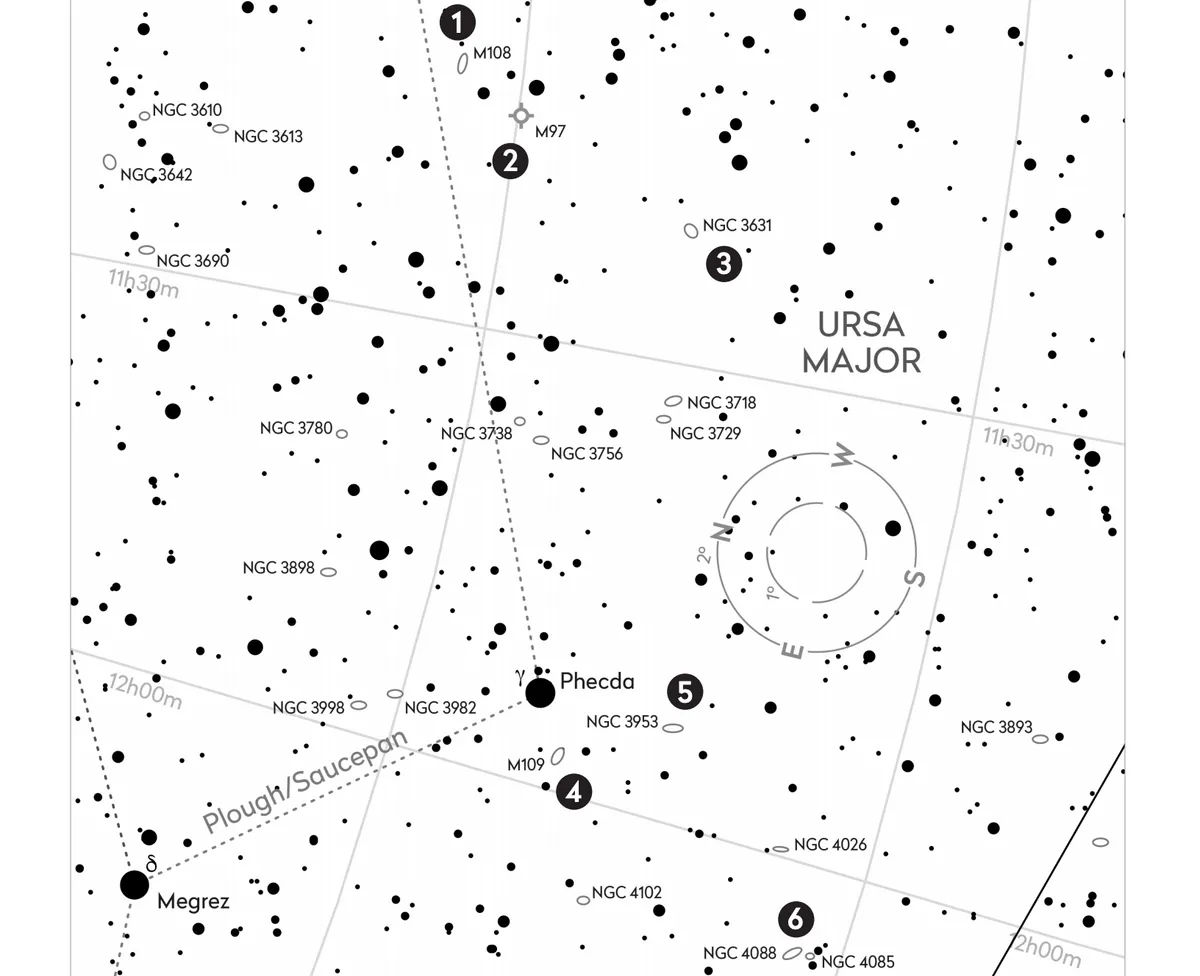In this guide we'll locate the galaxies and nebulae that fill the sky around Ursa Major.
1
M108
Messier 108 is a barred spiral galaxy in Ursa Major, located near the star Merak (Beta (β) Ursae Majoris). Merak marks the southwest corner of the pan of the Saucepan asterism, also known as the Plough. Locate the galaxy one-fifth of the way along the bottom of the pan from Merak towards Phecda (Gamma (γ) Ursae Majoris), the galaxy lying 19.7 arcmintes south of this position.
A 150mm scope shows an elongated object 8 arcminutes in length and less than 1.5 arcminutes wide. Increasing power reveals that this elongated glow is not uniform but has a mottled texture. Larger apertures show this well.
2
M97
M97 is a large and ghostly looking planetary nebula located 0.8˚ southeast of M108. Through a small scope it looks like a fairly even circular glow. A 250mm scope shows two dark patches, the whole affair resembling the face of an owl, hence M97 is known as the Owl Nebula. A 300mm scope at 150–200x power shows the ‘eyes’ well.
Each eye appears around 50 arcseconds across. M97 shines with an integrated magnitude of +9.9 and has an apparent diameter around 3 arcminutes, which gives it a low surface brightness. The dark eyes represent the openings of a tube-like nebula aligned so we see both openings within the nebula’s border. M97 lies at a distance of 2,300 lightyears.
3
NGC 3631
Next, we visit NGC 3631 a face-on spiral galaxy with an apparent magnitude of +10.1. It’s located 2˚ south-southeast of M97, around 2.3˚ south of the centre of the line which forms the bottom of the Saucepan’s pan. Although it has a reasonable magnitude for a galaxy, the fact that it appears face-on delivers an object with low surface brightness.
A 250mm scope shows a glow around 2 arcminutes in diameter with a core occupying one-quarter of its area. A 300mm scope increases the apparent size of the galaxy’s outer halo to 4 arcminutes.

4
M109
M109 is easy to locate. Extend the imaginary line from Merak through Phecda for 39 arcminutes (one-twelfth the length of the Merak-Phecda line). M108 is a good comparison for M109, the latter appearing a bit dimmer and smaller. Like M108, M109 is a barred spiral galaxy, but here tilted at a wider angle, giving it a thicker appearance.
A 150mm scope shows an oval glow 3x5 arcminutes in size, while a 250mm scope shows a faint halo with a concentrated core, 1.5x1 arcminutes in size. M109 shines at mag. +10.6.
5
NGC 3953
Another barred spiral galaxy, NGC 3953, is located 1.4˚ south of Phecda and shines at mag. +10.1. This galaxy has a brighter appearance than M109 due to it being presented at a reasonable tilt angle which maintains surface brightness. It also has an inner ring structure that circles its barred core.
It appears 5x2 arcminutes in size through a 150mm scope, increasing in width marginally as you up the aperture. At high powers through a 300mm instrument, the appearance of the galaxy becomes less homogenous and more granular thanks to tightly wound spiral arms that surround the core
6
NGC 4088
Our final stop is NGC 4088, an intermediate spiral galaxy located 3.6˚ south-southeast of Phecda, 2.7˚ southeast of NGC 3953. The other galaxies visited so far have all had linear elongations in the shape of their cores; the bars which give them their ‘barred’ classification. An intermediate spiral galaxy is a type which sits between a barred and an unbarred type.
NGC 4088 shines at mag. +10.5 and is easy to see through a 250mm scope with an apparent size of 5.5x3 arcminutes. A 300mm scope shows that the core shape is not regular, appearing to thin quite abruptly. At higher powers NGC 4088 appears quite mottled in appearance. The mag. +12.3 edge-on galaxy NGC 4085 lies 11 arcminutes to the south. NGC 4088 is estimated to be 52 million lightyears away. ο SEEN IT
